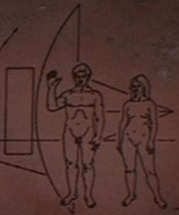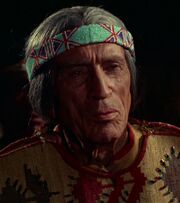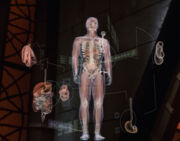(covers information from several alternate timelines)
The Humans (Homo sapiens), also known as Terrans, were a warp-capable humanoid species from the Alpha Quadrant. The species originated from the planet Earth, in the Sol system. Humans were the only surviving race of several sentient/intelligent species to have evolved from the Genus Homo. Humans were also one of two known spacefaring intelligent species to have originated from Earth; the other being the Voth, who had come to live in the Delta Quadrant by the 24th century. (VOY: "Distant Origin")
Overview

Human male and female as represented on the Pioneer 10 plaque
As the Latin word for their homeworld was "Terra", Humans were sometimes referred to as "Terrans", but not always. (This usage was consistent in the mirror universe.) Occasionally, the term "Terran" was used to distinguish Humans living on Earth from those resident on colonies on other planets and moons. Some people used the adjective "Terran" to refer to subjects or institutions associated with Humanity (Terran cuisine, Terran literature, Terran art, etc.). The Borg designation for Humans was Species 5618. (VOY: "Dark Frontier")
Dr. Zefram Cochrane
A founding member of the United Federation of Planets, Earth became warp-capable in 2063, which was the same year Humans experienced first official contact with an alien species, the Vulcans. The first warp-drive was engaged on April 5th of that year by Zefram Cochrane. (Star Trek: First Contact; ENT: "Broken Bow", "Desert Crossing", "E²"; VOY: "Year of Hell", "Relativity", "Homestead")
By the 24th century, Human society had changed from what it was for most of recorded history. On Earth, hunger, war, disease, famine, and poverty had largely been eliminated. The acquisition of wealth was no longer the primary driving force in the lives of many Humans. A great deal of emphasis was placed on the importance of continued social and personal development. Thanks to the non-currency-based New World Economy and the development of replicators, material needs were largely satisfied. Although money was no longer used by Humans within the Federation, they did use gold-pressed latinum and other forms of currency (such as Bajoran litas and credits) in places where it was still needed, such as Quark's. The idea behind not using money was that rather than seeking material possessions, Humans worked to better themselves and the rest of Humanity (see Human philosophy). (DS9: "Necessary Evil", "In the Cards"; Star Trek: First Contact) It must be noted that all of this more specifically applied to Humans within the Sol system, as many Earth colonies were known to have developed vast cultural differences from other Humans and some had even fallen into chaos, most notably Turkana IV. (TNG: "The Ensigns of Command", "Legacy")
Earth colonies
These colonies were established by various Earth governments or United Earth and largely remained in close contact and dependence with and on Earth. Most of them were older than the United Federation of Planets itself.
- Alpha Eridani II
- Colony Alpha 5
- Deneva colony (Deneva)
- Earth Colony II
- Lunar colonies (Luna)
- Lunar One Colony
- Orpheus Mining colony (possibly abandoned in 2154)
- Martian colonies (Mars)
- Proxima colony (Alpha Centauri system)
- Terra Nova colony (Terra Nova, abandoned in 2083)
- Vega colony
Human settlements unaffiliated with Earth

Goro, a Native American of Amerind
While achieving warp capability in 2063, there were Human populations on other planets prior to this. In these cases, they would usually have been brought there by alien species, who had traveled to Earth. For instance, Native Americans had been transplanted on Amerind by an unknown alien race called the Preservers sometime in the 19th century. In 2268, they still lived as hunters and gatherers. Captain Kirk was adopted into one of the tribes of Amerind, as the god Kirok. (TOS: "The Paradise Syndrome")
In 2153, the NX-class starship Enterprise, commanded by Captain Jonathan Archer, discovered a planet in the Delphic Expanse inhabited by six thousand Humans whose ancestors had been transplanted from the Ancient West during the late nineteenth century as slave labor by the Skagarans. (ENT: "North Star")
A Delta Quadrant species known as the Briori in 1937 abducted over three hundred people (among whom was Amelia Earhart, whose disappearance had never been explained) to be utilized as slave labor on one of their planets. In 2371, the USS Voyager crew discovered Earhart and Noonan, along with six other Humans, in a state of suspended animation, the only abducted Humans who had been left in stasis. By this time, the Humans had long since overthrown their Briori masters, and their descendants had established a thriving community on the planet. Upon being revived by the Voyager crew, Earhart and the others, who had come to be known as "the 37's" by the Human colonists, were given the option of joining the crew on their long journey back to the Alpha Quadrant. Earhart and the others declined, however, and elected to remain on the planet with the other Human colonists. (VOY: "The 37's")
Biology
Human and Earth DNA, like much of the life in the galaxy, was originally seeded by an ancient humanoid race (which shared similar DNA), and allowed to evolve under Earth's unique conditions. In time, they became Earth's animal biota, and one line evolved into Humans over millions of years. Humans are compatible with many other humanoid races across the galaxy because of this shared DNA. (TNG: "The Chase"; VOY: "Distant Origin") Many species are also affected by the same diseases across the galaxy because of the shared DNA. Some of Humanity's evolutionary ancestors included some kind of spider, amphibians, reptiles, primates, apes, and ultimately hominid proto-Humans; each was a separate link in the Humans' evolutionary chain, stretching back to the origins of all lifeforms on Earth. (TNG: "Genesis"; VOY: "Threshold")

A Human anatomical diagram
Bilaterally symmetrical bipedal primates, Humans were a warm-blooded humanoid species. (VOY: "Distant Origin"; ENT: "Azati Prime") They had two hands and two feet, each of which had five digits. The Human hand featured an opposable thumb and their fingers had multiple points of articulation. (VOY: "Distant Origin") The average Human life span had gradually increased during their history. At one point, it was only thirty-five years. (ENT: "Similitude") During the 22nd century, it was about one hundred years. (ENT: "Observer Effect") In the 24th century, Humans were known to live as long as 137 years as well, (TNG: "Encounter at Farpoint") in the 23rd century, as long as 144 years. (Star Trek)
Humans evolved from the australopithecines. (TNG: "Genesis") Several related species of humanoids, including the Neanderthals, co-existed on Earth some thirty-five thousand years prior to the 22nd century. Evolutionary pressures led to the extinction of these other species. In the 22nd century, Humanity's closest living relative was the chimpanzee. (ENT: "Dear Doctor", "The Xindi")
They had two sexes, as was common to many humanoid species. (ENT: "Cogenitor"; TNG: "The Outcast") The female of the species was fertile once a month after she reached puberty until the onset of a biochemical stage known as menopause. (TNG: "Manhunt") Human gestation was significantly longer than the Bajoran five months. (DS9: "Body Parts") The make-up of Human DNA structure was significant, as, with some modifications, it allowed them to crossbreed successfully with a wide range of other races across the galaxy, including Vulcans, Betazoids, and Klingons. (TOS: "Where No Man Has Gone Before"; TNG: "Encounter at Farpoint", "The Emissary"; VOY: "Caretaker", "Faces", "Lineage")
On average, Humans were not as physically strong as some species such as Klingons and Vulcans. (ENT: "Divergence"; TOS: "This Side of Paradise"; DS9: "Take Me Out to the Holosuite") They were, however, resilient in other ways. They were more adaptable to incarceration than Klingons. (DS9: "In Purgatory's Shadow", "By Inferno's Light", "Inquisition") They could survive with one lung or kidney, despite having two of these organs initially. (Star Trek IV: The Voyage Home; VOY: "Phage", "Fury", "Lineage") Humans could also go days without water and weeks without food due to their bodies' ability to conserve water and live off stored fat. (ENT: "Strange New World", "Shuttlepod One") Their bodies' efficient temperature regulation allowed them to resist and survive cold temperatures that would adversely affect other species such as Cardassians and Klingons or high temperatures that would be uncomfortable for an Andorian. (VOY: "Displaced"; ENT: "The Aenar") They also possessed more acute hearing than Cardassians. (DS9: "Distant Voices")
Humans were prone to strong, occasionally overwhelming emotions, such as love, hatred, embarrassment, and elation. (TOS: "Journey to Babel") Such feelings extended beyond sentient species. Many Humans anthropomorphized the lower lifeforms they kept as pets. Even fictional characters could elicit Human compassion. (ENT: "Dear Doctor")
Humans had iron-based hemoglobin in their blood. (TOS: "Obsession"; TAS: "The Pirates of Orion") Each individual's blood could be one of several blood types, which included AB-positive, O-negative, and B-negative. (ENT: "Carpenter Street"; DS9: "Broken Link", "In Purgatory's Shadow")
Culture
Various Humans working with other humanoids
Humans were easily the most outworldly, idealistic, and expansionistic race in the United Federation of Planets, and possessed those qualities in a greater degree than many of the alien races they encountered. Humans had no true specialty or extraordinary qualities and were average in both a technological and physical sense.
The Devore inspector Kashyk remarked that Human culture had many contradictions – such as violence and beauty, as well as science and faith – all somehow mingled harmoniously, similar to the counterpoint of a musical composition. (VOY: "Counterpoint")
Because Humans were the Federation species most interested in space exploration, they made up a large majority of Starfleet. The fact that Starfleet was originally a pre-Federation Earth organization also contributed to the Human dominance of Starfleet. Humans also made up the majority of colonists on Federation colonies.
Human adaptability and their strong tradition of innovation and cooperation brought them to the forefront of the current Federation interstellar situation. It was for this very reason, however, that Human society was constantly changing and evolving. This was seen not only on the isolated colonies, where the past traditions brought by culturally and geographically homogeneous blocks of colonists competed with new cultural pragmatism demanded of frontier life, but also in the staid and settled core worlds as well. Fashion, speech, and especially political views were constantly changing.
For species that were steeped in tradition and genealogical reverence as the basis of their societies, the Human fascination with the novel experience and their unending desire to innovate and explore, to discover for the sake of discovery, were all difficult concepts to grasp.
Jazz music persisted into the 24th century and became a contribution to galactic culture, as did opera music. Humans played music collaboratively in a format known as "classical music." (TNG: "11001001", "The Ensigns of Command", "Second Chances", "Phantasms"; DS9: "The Ship"; VOY: "Virtuoso", "Renaissance Man")
Competitive sports from Human cultures also became part of Federation culture in various ways. Sports played in the 24th century included soccer (also known as "football"), fencing, and wrestling. Other Human sports included water polo, baseball, and hockey. (ENT: "Minefield"; TOS: "The Naked Time"; Star Trek; DS9: "Apocalypse Rising", "Emissary"; VOY: "Critical Care")
Humans expressed themselves through various art forms. One such art form was known as dance. (TNG: "Data's Day"; VOY: "Lifesigns")
Human cuisine had a broad spectrum, and was shared widely with other cultures. Humans were omnivorous, unlike vegetarian Vulcan culture. A small sampling of Human dishes enjoyed by other species included pecan pie and chocolate. Human foods were often connected to a place, a language, or a family, and were a part of a richer cultural experience, such as jambalaya and oden. (TOS: "All Our Yesterdays"; ENT: "Breaking the Ice"; TNG: "The Game", "Liaisons"; VOY: "Prime Factors"; DS9: "Favor the Bold") In most human families, the woman shared in the cooking. (TNG: "Time Squared")
Human mating rituals sometimes involved a cultural ceremony known as a wedding to indicate a lasting commitment, as in other cultures, such as Vulcan and Klingon. (TNG: "Data's Day"; Star Trek Nemesis; ENT: "Breaking the Ice", "Home"; TOS: "Amok Time"; DS9: "You Are Cordially Invited", "'Til Death Do Us Part") According to divorcee Leonard McCoy in the alternate reality, "If an Earth girl says, 'It's me, not you,' it's definitely you." (Star Trek; Star Trek Beyond)
Human culture evolved to eliminate war, poverty and disease by the year 2113. (Star Trek: First Contact; ENT: "Broken Bow"; TNG: "Time's Arrow, Part II")
Humanity's children
In later centuries, Humans expanded on their desire to seek out new life by turning inward, demonstrating their abilities to create new life in their own image.
The stronger, more intelligent and physically resilient 20th century Augments may or may not have qualified as a separate species, but following his experience with Augments in the 22nd century, Dr. Arik Soong abandoned genetics for cybernetics. His work was continued and fulfilled by Dr. Noonian Soong, who created a series of sentient Soong-type androids, including Lore, B-4, Juliana Soong (the nearly perfect reproduction of his then-comatose wife), and Data (the first android to be officially ruled by Federation law as sentient, and who proved capable of reproduction by creating his own daughter, Lal). (TOS: "Space Seed"; ENT: "The Augments"; TNG: "Datalore", "The Measure Of A Man", "Inheritance"; Star Trek Nemesis)
Humans also used holographic technology to sprout new sentient life, beginning with the first self-aware holographic character, James Moriarty, in 2365. The work of Dr. Lewis Zimmerman on Emergency Medical Holograms birthed The Doctor, Humanity's most complex photonic lifeform, developed in the later 24th century. (TNG: "Elementary, Dear Data"; VOY: "Caretaker")
Alternate timelines
- In an alternate timeline, Humanity was assimilated by the Borg in 2063 after the Borg prevented first contact between Humans and Vulcans. This timeline was erased when the USS Enterprise-E traveled back in time from the year 2373 to 2063 and ensured that first contact took place as history recorded it after all. (Star Trek: First Contact)
- In another alternate timeline, Humanity was nearly wiped out by the Xindi in 2154, who destroyed not only Earth, but Mars, the Alpha Centauri colony, and the Vega colony, so only 6,000 Humans survived. These Humans escaped to Ceti Alpha V. This alternate timeline was undone in 2165, when an experimental treatment was able to retroactively remove interspatial parasites which had nested in the brain of Captain Jonathan Archer in the year 2153; with the parasites no longer rendering him unfit for duty, Archer was able to remain in command of Enterprise, and successfully prevented the Xindi weapon from destroying Earth. (ENT: "Twilight")
Mirror universe
- Main article: Terran (mirror)
In the mirror universe, Humans were known as Terrans and were the founders of the Terran Empire. They were filled with fear and suspicion when a Vulcan scout ship landed on Earth to initiate first contact in 2063. The Humans slaughtered the Vulcan crew and used the technology within to create an interstellar empire. (ENT: "In a Mirror, Darkly")
This Empire lasted centuries until it was overshadowed by the equally vicious aspirations of the Klingon-Cardassian Alliance. Although many races in the mirror universe harbored hopes of forming a peaceful alliance to protect civilization, Terrans were rarely found among these rebels due to the wealth and safety afforded by their violent expansionist policies. (DS9: "Crossover")
Aliens becoming Human
- Q (punishment by the Q Continuum)
Other information
- The Borg designation for Humans was "Species 5618". Humans were considered by the Borg to possess below-average cranial capacity, minimal redundant systems, and limited regenerative abilities. (VOY: "Dark Frontier")
- The Klingon, Vulcan, and Ferengi words for Human were spelled exactly the same ("Human"), although the Klingon was pronounced with a rough fricative, much like the "ch" in "Bach" or "Loch", and the Vulcans changed it to "Khuman". Klingons also referred to them by the name of their home planet Terra, tera'ngan, and the Ferengi changed the pronunciation of the "a" in Human, pronouncing it as "hyu-mon". (citation needed • edit)
- Q once stated that the Human race would one day become more powerful than the Q. (TNG: "Hide and Q")
- Occasionally, the term "Human" was used to describe races even though no link to Earth was evident, such as the Beta III natives or Lazarus' race.
Appendices
See also
Related topics
- Human history
- Human philosophy
- Cetacean
- Humans
- Augment
- Neanderthal
- Human recreational activities
- Human foods and beverages
- Examples of Human artists, musicians and works of literature
Background information
Humans are the only species to have made an appearance in almost every episode to date of all eight Star Trek series and all thirteen films (except VOY: "Living Witness", though several holographic representations of Humans are present in that episode). In addition, the plurality of the lead characters of every Star Trek series so far have been Human.
In the final draft and the revised final draft of the script for TOS: "The Enemy Within", Leonard McCoy submitted that part of "the Human condition" was having "an enemy within."
External links
- Human at Memory Beta, the wiki for licensed Star Trek works
- Human (Star Trek) at Wikipedia
